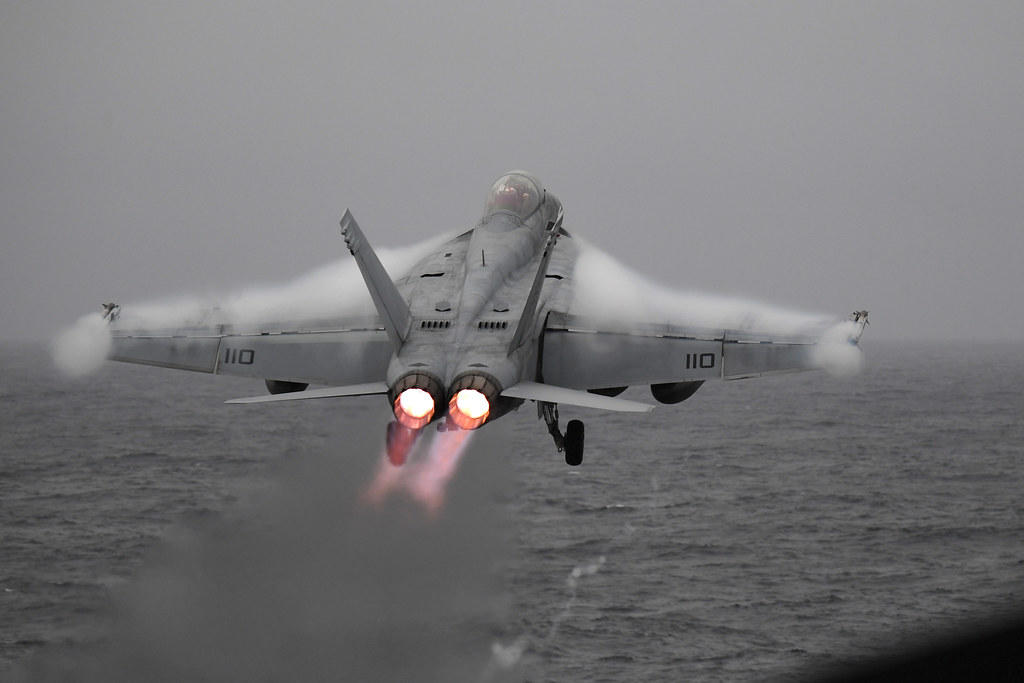
GULF OF OMAN (Nov. 1, 2008) An F/A 18 Super Hornet, assigned to the “Blacklions” of Strike Fighter Squadron (VFA) 213, flies over the aircraft carrier USS Theodore Roosevelt (CVN 71) during flight operations. VFA-213 is assigned to Carrier Air Wing (CVW) 8. The Theodore Roosevelt Strike Group is on a scheduled deloyment to the U.S. 5th Fleet area of responsibility, and is focused on reassuring regional partners of the United States’ commitment to security, which promotes stability and global prosperity. (U.S. Navy photo by Lt. Cmdr. Johnnie Caldwell/Released)
The F/A-18 Hornet has been a symbol of U.S. naval air power for four decades. This iconic aircraft, born from the Navy’s Fighter-Attack, Experimental (VFAX) program, has etched its name in military aviation history with its adaptability, reliability, and combat prowess.

GULF OF OMAN (Feb.16, 2010) Cmdr. Thomas Bush, commanding officer of Strike Fighter Squadron (VFA) 131, executes a high-speed fly-by in an F/A-18C Hornet over the aircraft carrier USS Dwight D. Eisenhower (CVN 69) during a change of command ceremony. Bush was relieved by Cmdr. Benjamin Hewlett. Dwight D. Eisenhower is conducting a scheduled six-month deployment as a part of the on-going rotation of forward-deployed forces. (U.S. Navy photo by Mass Communication Specialist 3rd Class Chad R. Erdmann/Released)
From its first flight in the late 1970s to its last operational deployment in 2018, the Hornet has been more than just an aircraft; it has been a stalwart guardian of the skies.

The Hornet’s story is one of evolution and excellence. Designed to replace older models such as the A-7 Corsair II and to complement the legendary F-14 Tomcat, the F/A-18 was a testament to the ingenuity of McDonnell Douglas and Northrop Grumman.

With cost-effectiveness in mind, the U.S. Navy allocated funds from the Air Force’s Lightweight Fighter Program to develop what would be a new Naval Air Combat Fighter, capable of performing both attack and fighter roles.

The resulting aircraft, the F/A-18 Hornet, featured significant modifications for carrier operations, catapult attachments, strengthened landing gear, and folding wings that gave it a distinct edge.

Its ease of maintenance was unparalleled, requiring half the maintenance time compared to its predecessors.

“The platform was powered by General Electric F404 engines, which were cutting-edge at the time,” adding to its reliability and performance.

The Hornet’s multifunction displays were revolutionary, allowing pilots to switch seamlessly between fighter or attack roles.

Its first combat engagements came in the mid-1980s against Libyan air defenses, and during the 1991 Gulf War, it proved its mettle by securing two aerial victories against MiG-21s. These engagements showcased the Hornet’s versatility and its critical role in maintaining aerial superiority.

The Hornet not only served in combat but also became a symbol of American air power and precision through the Blue Angels, the U.S. Navy Flight Demonstration Squadron.

Pacific Ocean (Nov. 1, 2004) – An F/A-18F Super Hornet assigned to the ÒBounty HuntersÓ of Strike Fighter Squadron Two (VFA-2), lower right, and an F/A-18C Hornet assigned to the ÒMaraudersÓ of Strike Fighter Squadron Eight Two (VFA-82), conducts in-flight refueling from a U.S. Air Force KC-135 Stratotanker assigned to the Alaska Air National Guard. Both fighter aircraft are assigned to Carrier Air Wing Two (CVW-2), currently embarked aboard the Nimitz-class aircraft carrier USS Abraham Lincoln (CVN 72). U.S. Navy photo by Lt. Perry Solomon (RELEASED)
The Hornet is the longest-serving aircraft with the squadron, having replaced the A-4 Skyhawk in 1986. This transition marked the Hornet’s place not just in combat but also in the hearts and minds of the public.

While the last operational Hornet flight occurred in 2019, its legacy lives on through the Super Hornet variant, which continues to be a critical asset for the U.S. Navy.

The Super Hornet, boasting updated avionics and enhancements, demonstrates the Hornet family’s ability to adapt to the changing demands of modern warfare.

The F/A-18 Hornet’s service record is a testament to its design and the strategic foresight of the U.S. Navy.

As defense analyst Maya Carlin noted, “Throughout the years, consistent upgrades to the Hornet series of jets has helped the platform retain an edge over competitors.
“Relevant articles:
– The F/A-18 Hornet Is a U.S. Navy Fighter Jet Legend That Dominates, The National Interest
– 18: Hornet, United States Navy (.mil)
– 7 of the deadliest fighter jets still in active service, Interesting Engineering
– Why the F/A-18 Is Such a Badass Plane, Popular Mechanics

